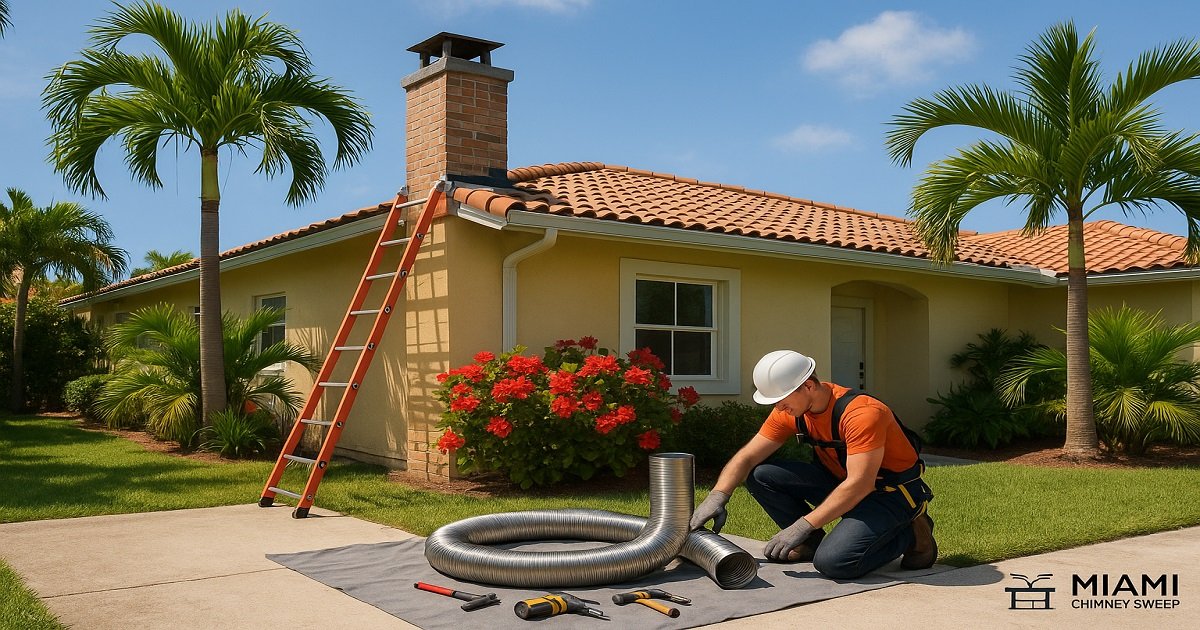So, you’re thinking about buying a home in Miami, and you spot a cozy fireplace. While fireplaces are rare gems in South Florida homes, a surprising number of places—be they stylish old bungalows or more modern builds—still have them. One thing that might not be on your radar? Chimney liner. Don’t worry, you’re not alone! Let’s break down what these liners are, why they matter, and what you should know before you sign the dotted line on your Miami dream home.
Getting to Know Chimney Liners: Key Features
Imagine your chimney as a giant straw that carries smoke and fumes from your fireplace safely out of the house. Inside that straw, there’s a hidden layer—the chimney liner—which acts like a protective sleeve. Its job is to shield your home from heat and dangerous gasses, and to help smoke exit smoothly.
Chimney liners come in a few different materials. Some Miami homes might have clay tile liners, while others could use metal or even a kind of cement mixture. Each has its own perks and quirks. Here’s a quick look at what you might find:
| Type of Liner | Common Material | Pros & Cons |
|---|---|---|
| Clay Tiles | Fired ceramic tiles | Affordable and long-lasting, but can crack over time, especially in humid or stormy weather. |
| Metal Liners | Stainless steel or aluminum | Durable and flexible—good for older chimneys. Can rust if exposed to salty air or leaks. |
| Cement Liners | Poured-in or cast cement | Strong and seamless, but tough to install in existing chimneys and can be pricey. |
In Miami’s salty, humid air, metal liners (especially stainless steel) often hold up best, but everything depends on your specific house and setup.
Why Safety Starts with Your Chimney Liner
When it comes to fireplaces, safety isn’t just a nice-to-have—it’s a must. The chimney liner is your home’s silent guardian. If it’s cracked, missing, or just old and worn out, heat and smoke can sneak into areas they shouldn’t, like your attic or behind your walls. That’s how fires can start or how carbon monoxide could build up in your living spaces.
South Florida’s storms and humidity can speed up wear and tear on liners, so even if the home is relatively new, it’s smart to have a pro look things over. Inspections can reveal hidden problems—think small cracks or rust—that you wouldn’t spot on your own.
“A little attention to your chimney liner today can save you from big headaches tomorrow.”
If you’re buying, ask for a chimney inspection report. If the liner needs work, it’s better to know before you move in and light that first fire.
The Cost Factor: What Should You Expect?
Money matters, especially when you’re already investing in a new home. The price of repairing or replacing chimney liners in Miami can vary a lot, depending on liner type, chimney height, and the overall condition. Here’s a ballpark idea:
- Simple repairs (patching cracks, sealing gaps): $200–$700
- Full metal liner replacement: $1,500–$3,500 (higher for larger chimneys)
- Clay or cement liner work: $2,000–$5,000+, especially if a full relining is needed
Keep in mind, Miami’s unique climate can sometimes mean extra steps—like waterproofing or using salt-resistant materials—which can bump up the cost a bit compared to other regions.
Before you buy, try to get a full breakdown of the chimney’s condition. If the liner needs attention, you might be able to negotiate repairs into the sale, or at least budget for them.
When Things Go Wrong: Emergency Services in Miami
Picture this: it’s a rare chilly night in Miami, you light the fireplace, and suddenly smoke is filling the room or you smell something weird. That’s when you need to know who to call—fast. Emergency chimney services exist in Miami, and many are used to dealing with problems caused by storms, humidity, or even nesting critters.
If you ever spot any of these red flags, don’t wait:
- Smoke inside the home (not just a little, but anything unusual)
- Strong, odd smells coming from the fireplace
- Visible cracks or chunks of tile/metal in the fireplace
Most chimney pros can respond quickly and will check the liner as part of their emergency inspection. Keep the number of a local, trusted chimney service in your contacts—just in case.
FAQs: Miami Homebuyers & Chimney Liner
Q: Is a chimney liner really necessary in Miami homes?
Absolutely. Even if you rarely use the fireplace, the liner protects your home from heat and fumes year-round.
Q: How often should I get my chimney liner checked?
Once a year is a good rule—especially after hurricane season, or if you notice anything odd.
Q: Can I check the chimney liner myself?
You can look for obvious cracks or loose tiles, but many problems are hidden out of view. A professional inspection is best.
Q: Does homeowners insurance cover liner repairs?
Sometimes, but not always. If the damage is sudden (like from a storm), you might be covered. Wear-and-tear usually isn’t included.
Final Thoughts: Chimney Liner Shouldn’t Be Overlooked
Chimney liners might not seem like the most exciting part of buying a Miami home, but they’re quietly essential. They protect your family, keep your air clean, and make sure your cozy nights by the fire stay safe and worry-free. Before you sign on your new place, ask about the chimney liner—your future self will thank you!
Read More: Miami Chimney Sweep
